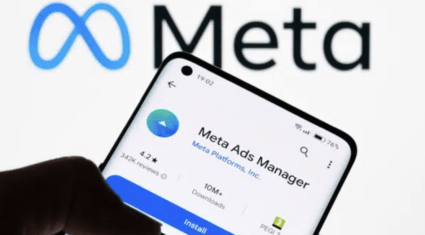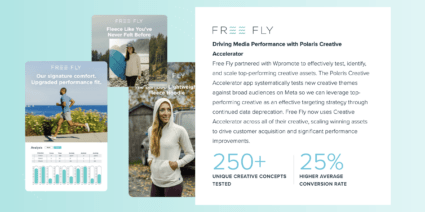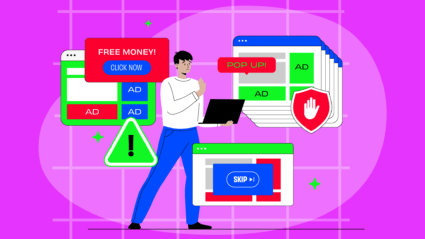Table of Contents
It’s probably happened to you before: You see a clever new ad on social media, streaming services, or anywhere else. You see it again, and it’s still fun, but it’s lost a little shine.
Fast forward until you’ve seen it 30 more times, and you instantly hit the mute button or scroll past every time it pops up.
That’s advertising fatigue, and—not to scare you—it’s probably happening in your audience right now. With US users spending more than eight hours a day with digital media, according to eMarketer, often on ad-supported platforms, audiences are viewing a lot of ads every day. Combine that with audiences’ shrinking attention spans and marketers often reaching for the same creative that’s worked before, and you have a recipe for repetitive advertising that sends potential customers to sleep.
How can your brand break through to jaded consumers who feel like they’ve seen your ad (or something like it) a million times over? We’ll look at the root causes of ad fatigue and some strategies that can help brands overcome it–as well as a few key data points that can help you catch this phenomenon before your potential customers are ready to hit “Skip” on all your ads.
What is ad fatigue?
Ad fatigue is the decrease in engagement that happens when audiences see similar or identical ads too many times. When ad fatigue sets in, you might be looking at consequences like:
- Lower engagement
- Higher customer acquisition costs
- Wasted media spend
It’s not just the frequency with which a customer sees ads for your brand. It’s also a problem of stale, repetitive, and/or off-target creative.
What causes ad fatigue in digital marketing?
The specific causes of ad fatigue can vary, but usually, it comes down to some combination of the following:
Overexposure to the same creative
Human brains crave novelty, and bringing out the same visuals or copy time after time will drain your audience’s attention span quickly. It’s easy to fall into the trap of recycling creative: New creative costs money and time, and businesses want to get the most bang for their buck out of what they’ve already created. But that strategy can become counterproductive when consumers notice a lack of variety.
Narrow audience targeting
When you target a smaller pool of platform users, you’ll tend to run out of new eyeballs more quickly. A targeting pool that includes all women 18 to 35 will likely reach the point of ad fatigue much less quickly than one that includes, for example, only women 18 to 24 who live in Florida and have previously interacted with an ad. Instagram retargeting and other narrow targeting tools can still be essential components of a holistic strategy, but carefully considering your audience size and growth goals will help you avoid plateauing your reach too quickly.
Platform algorithm limitations
Most automated ad service platforms like Meta Ads Manager use algorithms that serve what they consider the best-optimized content to the audience. That can quickly become an issue if some of your content is well-optimized and other content strays more from best practices. Algorithms will likely keep pulling just your best-optimized content to the top—where audiences may get tired of it more quickly than you’re anticipating. This is especially problematic when you’re running “set and forget” campaigns that lack more specific contextual clues for when to switch it up.

Source: Search Engine Land
How to spot ad fatigue early
Identifying ad fatigue early will help you nip it in the bud and minimize wasted spend. Here are some KPIs to watch that can tell you when ad fatigue might be setting in:
Declining CTRs or engagement
Keep an eye on your click-through rates and engagement in your marketing data platforms. Declines in these metrics without changes in budgets or targeting can be a signal that your creative is getting stale. Most platforms, including Meta Ads Manager and Google Ads, give advertisers built-in options to track key metrics like CTR.
Rising CPAs or CPCs
Likewise, if your cost per acquisition (CPA) or cost per click (CPC) keep rising, a creative refresh might be necessary. Over time, worn-out ads create cost inefficiencies. You don’t want to keep paying for placements on creative that’s no longer performing at the rate it used to.
Audience disengagement
Some other metrics can indicate that your audience is checking out from your creative include:
- Declining conversion rate
- Reduced time spent on site
- Negative sentiment in ad comments
For most advertisers, there’s no single magic metric to track—it’s more about keeping a holistic perspective on your performance and making adjustments when you see the signs of trouble.
How to prevent and combat ad fatigue in digital marketing
Of course, the best time to fight ad fatigue is before it happens. By proactively mixing it up with a data-driven creative strategy, you can help your brand avoid the stressful scenario of scrambling for new creative when KPIs start to drop.
These are some of the go-to tactics our paid social and paid search service experts frequently use with our clients:
Refresh creative regularly
The most direct solution to overused creative is to regularly change it up. That doesn’t have to mean blowing a hole in the budget for new photoshoots every other week.
Instead, try ideas like:
- Creating a content calendar to automatically rotate creative on a rolling basis
- Integrating user-generated content (UGC) to add a more personal element
- Incorporating seasonal themes, such as building campaigns around holidays or traditions
- Making small tweaks like swapping taglines or background colors
Build and use a modular creative system
A mix-and-match approach is a smart way to stretch your assets. Try creating campaigns with a large base of templates, assets, and copy that you can switch up as needed. Today, ad platforms make this easier than ever, as most of the major players offer dynamic optimization tools that will automatically combine different assets and track their performance.
Customize creative by audience and funnel stage
Segmentation is another key element of keeping your creative punchy and relevant. For many brands, creative can and should look different depending on who’s viewing the ad and where they are in the sales journey. Successful top-funnel creative often focuses on product and brand awareness, while mid- and bottom-funnel tends to be aimed at differentiating from competitors and nudging the customer toward conversion.
Implement an always-on creative testing plan
Continuously testing your creative is a key part of keeping it fresh and relevant. Industry-standard testing methods like creative A/B testing allow you to scale what works and retire what doesn’t. You can also leverage tech like Wpromote’s Polaris IQ Creative Accelerator, an AI-powered testing tool that lets advertisers launch test campaigns in Meta Ads to identify high-performing creative—generating an average of 91% ROAS lift in our beta tests.

Source: Wpromote
Performance solutions for creative problems
Ad fatigue is a creative problem, but the most effective solutions are performance-driven. Brands that strategically test and iterate their creative assets can get more mileage from their creative and improve performance over time.
Wpromote’s Performance Creative services bridge the brand and performance gap with data-informed storytelling and assets. Looking to future-proof your paid social and search campaigns with high-performance creative? Get in touch with our Performance Creative storytellers today.
Frequently Asked Questions
What are the signs indicating your audience is experiencing ad fatigue?
Some of the most reliable indicators of ad fatigue appear in your performance data. If your click-through rates (CTR) are declining without any changes to budget or targeting, or if you’re noticing rising cost per acquisition (CPA) or cost per click (CPC), it might be time for a creative refresh. You may also notice signs of audience disengagement, such as negative comments, reduced time spent on site, or declining conversion rates. No single metric tells the full story, but taken together, these red flags can help you spot when your audience has seen enough.
How can you refresh ad content to combat ad fatigue?
You don’t need to completely reinvent your creative to keep it fresh. Small, intentional changes can go a long way. Try rotating in updated visuals or new copy regularly, experimenting with user-generated content to bring in authentic voices, or building campaigns around seasonal or cultural moments. Even light edits like adjusting your tagline, switching up background visuals, or reworking a call to action can help extend performance and keep your audience engaged over time.
How often should ad creatives be updated for optimal performance?
There’s no one-size-fits-all answer, but most brands should plan to refresh ad creative every few weeks to every couple of months, depending on how often the ad is shown and how narrowly the audience is targeted. The more frequently your audience sees your creative, the faster fatigue can set in. If you’re running high-volume or always-on campaigns, creative should be rotated more often to avoid declining performance.
Rather than guessing when to make a change, it helps to use tools that surface those insights for you. Wpromote’s proprietary Polaris IQ platform includes a Creative Audit feature that quickly reviews your video assets and flags potential performance issues. It helps you make smarter decisions faster so you can avoid wasting spend on creative that isn’t pulling its weight. Learn more about Polaris IQ here.







Responses